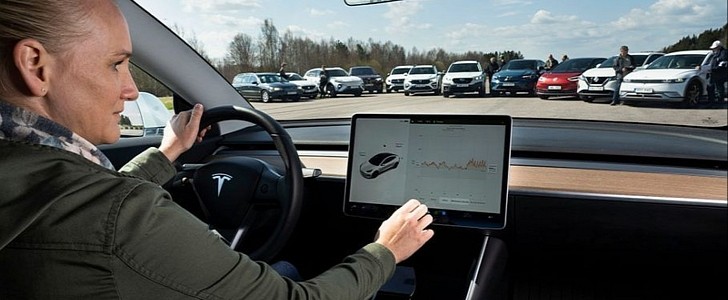Carmakers started to copy the touchscreen smartphone interface to replace the physical buttons inside their vehicles. But what works for a smartphone is not necessarily suitable for cars, and sometimes it can prove outright dangerous.
Carmakers have become obsessed with touchscreens in the past years. Each generation of vehicles brings bigger screens and sometimes more of them. It’s safe to say that Mercedes-Benz got to the extreme by extending the car display across the entire dashboard, as in, you cannot go any further than that. Or maybe you can, but you shouldn’t. That’s because it has been proven that accessing essential functions on a touchscreen is more difficult in a moving car than pressing or rotating a physical button. And if you need to keep your eyes on the road, touchscreens are a horrible idea.
Many people have suspected this for some time, although Tesla owners swear by the TV screens inside their vehicles. Now we know for sure, after the guys at the Swedish car magazine Vi Bilägare (literally “We, the Car Owners”) tested the human-machine interfaces in twelve cars. While eleven were modern vehicles with touchscreen controls, the twelfth was a 17-year-old Volvo V70 with “old-school” buttons all over the dashboard.
The test required drivers to perform simple tasks, such as changing the radio station, adjusting the climate control, resetting the trip computer, and dimming the instrument lighting while the car was moving at 110 km/h (68 mph). The time needed to complete all tasks was recorded, serving as the base for the results. Before the test, the journalists took their time to familiarize themselves with the car’s infotainment systems. This was intended to make the test more realistic.
The worst performing car (MG Marvel R) travels as much as 1,400 meters (1,531 yards) in the time needed to perform all the tasks above, which is 45 seconds. At the same time, the old-school Volvo driver needs only 10 seconds to complete the same tasks, during which the V70 travels 306 meters 1,004 feet). This shows how easy it is to operate a button interface, even when the car in the test (Volvo V70) has a dashboard filled with buttons, which are not always ergonomically arranged.
Not far behind the MG Marvel R, the BMW iX puts the driver to a heavy workload just to navigate the complex menus. That’s not even the worst-case scenario, though. Money-saving decisions mean that Volkswagen ID.3 (probably ID.4 too) have touch-sensitive climate controls that are not illuminated, making them completely invisible at night. Finally, the best of the touchscreen crowd proved to be the Volvo C40 (of course, it’s Swedish, you’d argue), thanks to the simplicity of the interface.
Many people have suspected this for some time, although Tesla owners swear by the TV screens inside their vehicles. Now we know for sure, after the guys at the Swedish car magazine Vi Bilägare (literally “We, the Car Owners”) tested the human-machine interfaces in twelve cars. While eleven were modern vehicles with touchscreen controls, the twelfth was a 17-year-old Volvo V70 with “old-school” buttons all over the dashboard.
The test required drivers to perform simple tasks, such as changing the radio station, adjusting the climate control, resetting the trip computer, and dimming the instrument lighting while the car was moving at 110 km/h (68 mph). The time needed to complete all tasks was recorded, serving as the base for the results. Before the test, the journalists took their time to familiarize themselves with the car’s infotainment systems. This was intended to make the test more realistic.
The worst performing car (MG Marvel R) travels as much as 1,400 meters (1,531 yards) in the time needed to perform all the tasks above, which is 45 seconds. At the same time, the old-school Volvo driver needs only 10 seconds to complete the same tasks, during which the V70 travels 306 meters 1,004 feet). This shows how easy it is to operate a button interface, even when the car in the test (Volvo V70) has a dashboard filled with buttons, which are not always ergonomically arranged.
Not far behind the MG Marvel R, the BMW iX puts the driver to a heavy workload just to navigate the complex menus. That’s not even the worst-case scenario, though. Money-saving decisions mean that Volkswagen ID.3 (probably ID.4 too) have touch-sensitive climate controls that are not illuminated, making them completely invisible at night. Finally, the best of the touchscreen crowd proved to be the Volvo C40 (of course, it’s Swedish, you’d argue), thanks to the simplicity of the interface.







